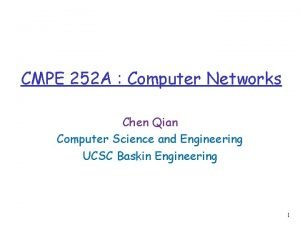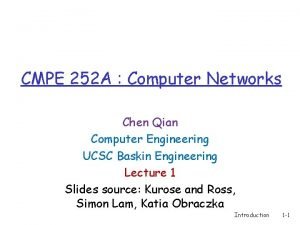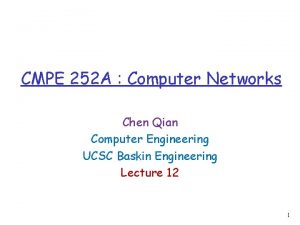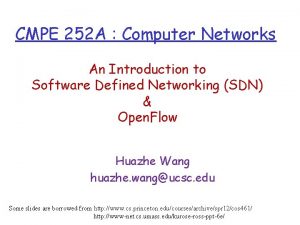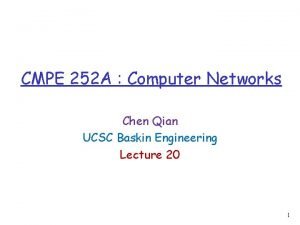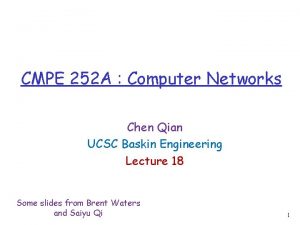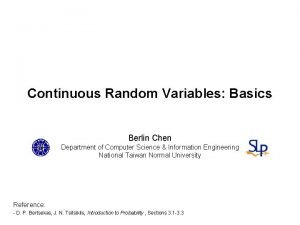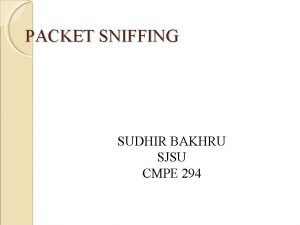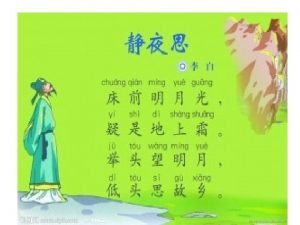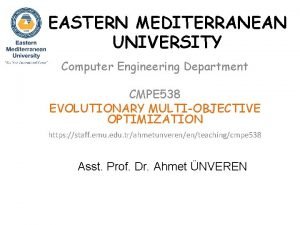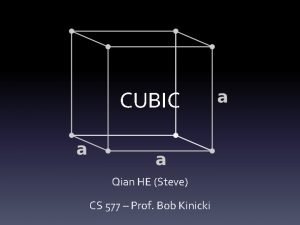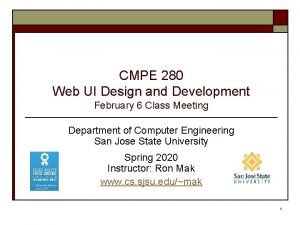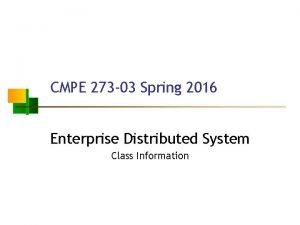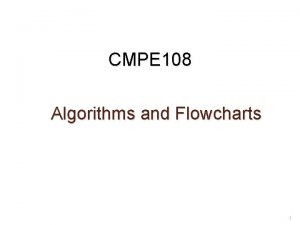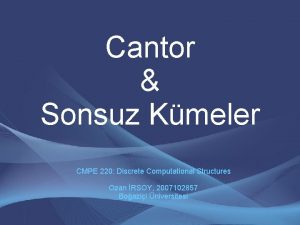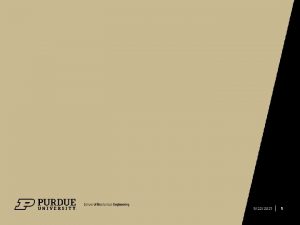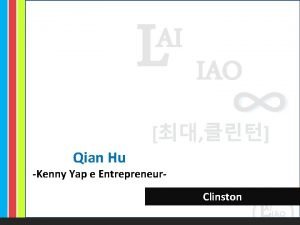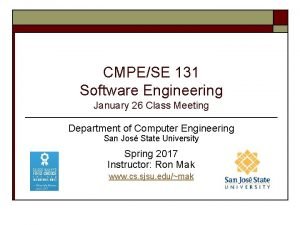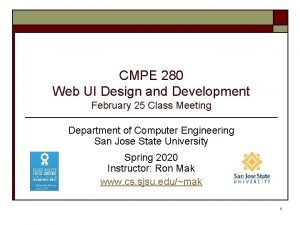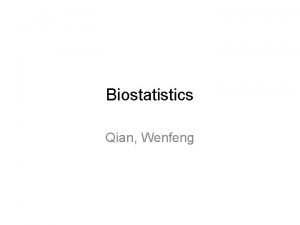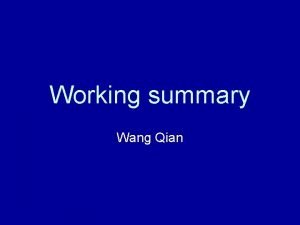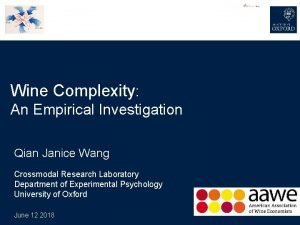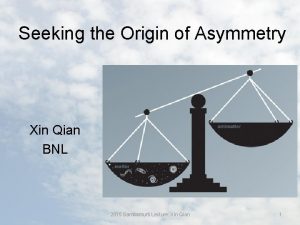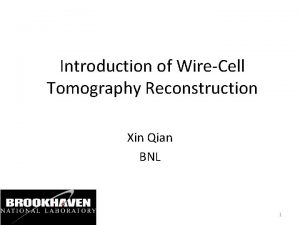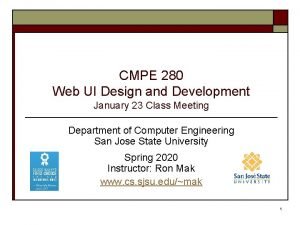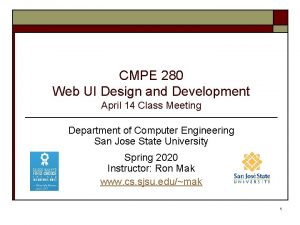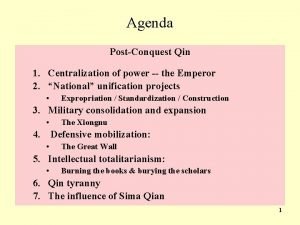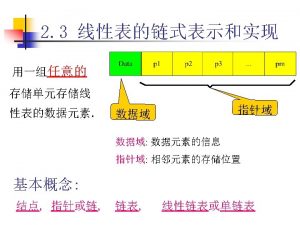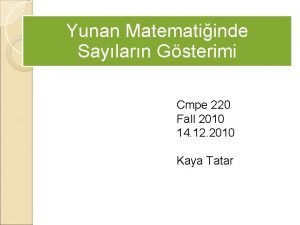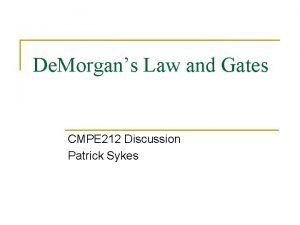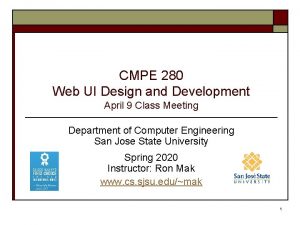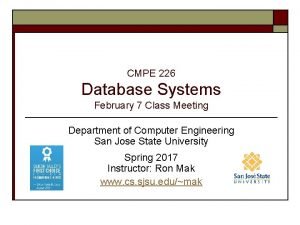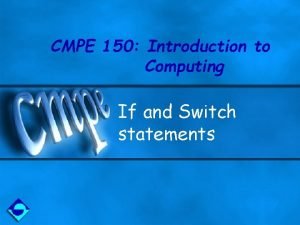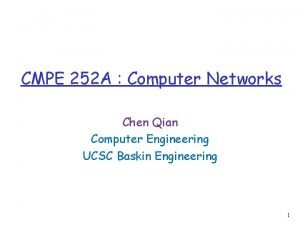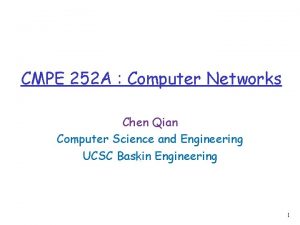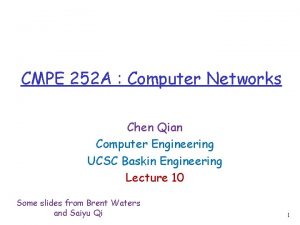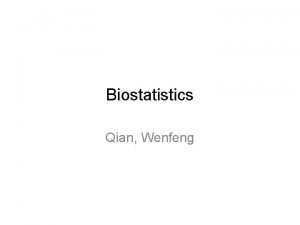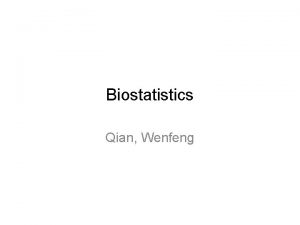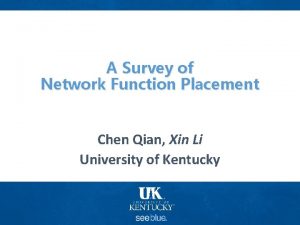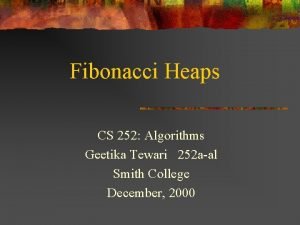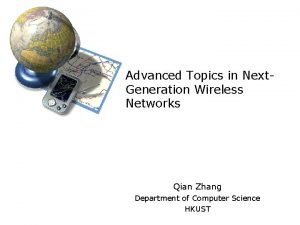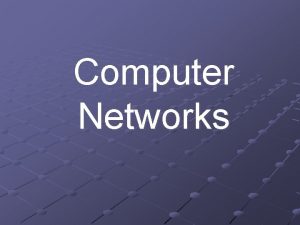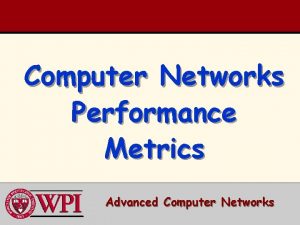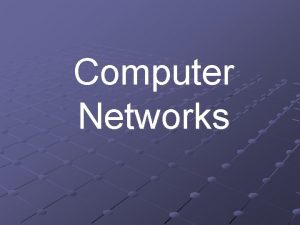CMPE 252 A Computer Networks Chen Qian Computer





































- Slides: 37

CMPE 252 A : Computer Networks Chen Qian Computer Engineering UCSC Baskin Engineering Lecture 1 Slides source: Kurose and Ross, Simon Lam, Katia Obraczka Introduction 1 -1

Welcometo. CE 252 A! Class information: q When: MWF 09: 20 -10: 25 AM. q Where: Engineering 2 194. q Class Web page: https: //cmpe 252 a-fall 18 -01. courses. soe. ucsc. edu/home It is your responsibility to read EVERY sentence on the class website. You also need to check the website at least twice every week to access timely updates to the class 1 -2

About the Instructor q Chen Qian. v Office: E 2 231. v E-mail: qian "at" ucsc. edu v Office hours: Wednesday, 11 am-12 pm v Research lab: E 2 211 1 -3

Pre-Requisites q CMPE 150 or undergrad level networking course. q Graduate level computer programming skills (for project). 1 -4

Teaching Assistants q Shouqian Shi sshi 27@ucsc. edu 1 -5

Books q Lecture: v Computer Networking: A Top Down Approach, by Kurose and Ross 5 th, 6 th and 7 th ed are all good You are recommended to read the book BEFORE some classes. However the exam questions are ALL related to the material in the slides. Highly recommend to buy it! It is good based on my experience. 1 -6

Grading q Reading reports 15% q Survey study 30% (20 writing + 10 presentation) q Midterm 25% q Course project 30% 1 -7

Student Responsibilities: Academic Integrity q All submitted work must be individual. v OK to have discussions on ideas but turn in your own work. • Survey and Project can be done in a group of at most two students. But each student must submit her/his own report about her/his own contribution. v Ask instructor and TAs if there any questions. v For more info, go to: www. ucsc. edu/academics/academic_integrity/ 1 -8

Student Responsibilities: Academic Integrity q Academic integrity violations will not be tolerated. q Cheating quizzes. 1 -9

Student Responsibilities q Attendance. v Lectures. q Keep up with material covered in lecture v Readings (chapters in the book). v Sample questions. q Keep up with reading assignments and project. q Turn in the assignments on time! 1 -10

Resources q Instructor. q TAs. q Class Web page. v Lecture notes will be posted before class. q Office hours 1 -11

Student Feedback q Feedback is always welcome! q Chance to do it at the end of the quarter. q But you can also do it during the quarter… 1 -12

Lectures q The more interactivity, the better! v Ask questions! v Or answer my questions. q Lecture notes: v Will be posted on-line before class. v But… 1 -13

Project q You may choose one of the following. q 1. Recommended Project q 2. Self-defined Project q Any topic related to networking q Need approval from me to continue q Detailed guideline: q https: //cmpe 252 a-fall 1801. courses. soe. ucsc. edu/node/5 1 -14

Reading reports q There around 15 research papers for the instructor/TA to present in total. You should submit no fewer than 8 reading reports. q Each report will be graded as a check(1 pt), check (1. 5 pt), or check+ (2 pt). q You may submit more but we only count the 8 reports with highest grades. Introduction 1 -15

Survey paper q You are allowed to work in a group of two on the survey paper. Among the 30 points of the survey paper, 20 will be based on the writing and 10 will be based on your presentation and Q&A. q Detailed guideline: v https: //cmpe 252 a-fall 1801. courses. soe. ucsc. edu/node/3 Introduction 1 -16

Midterm Exam q November 2 nd. q Close book, can bring one-side 8. 5"x 11" note Introduction 1 -17

Assignment late submission policy q 20% deduction for each day late. 18

Submission site q Reading reports: canvas q Survey: canvas q Project: gitlab Introduction 1 -19

Administrative Info q Communication: v E-mail preferred. v Send e-mail to both instructor AND TAs. 20

Course Outline q Basic Knowledge of computer networking q Application layer q Transport layer q Network layer q Link layer q Advanced topics q Software defined networks q Cloud and data center networks q Wireless and mobile networks q Internet of things q Network security q Edge computing 1 -21

My background q Ph. D in Computer Science (2013), University of Texas at Austin q Advisor: Simon Lam – researcher of the chapter for “The Link Layer” pp 511 22

BTW…. q Simon Lam’s Ph. D advisor was Leonard Kleinrock, Professor at UCLA q researcher of the chapter for “Chapter 1” Introduction 1 -23

My Research q Network algorithms, protocols, and systems v Routing, switching, management, etc. q Current focus: Internet of Things, Software Defined Networking, and Network Security Introduction 1 -24

Networks: overview 1. 1 Terms of a network 1. 2 network edge § end systems, access networks, links 1. 3 network core § packet switching, circuit switching, network structure 1. 4 protocol layers Introduction 1 -25

What are the components of a computer (communication) network? q Links, nodes, and v Terminals/hosts/end systems/servers q What’s the difference between “nodes” and “hosts”? 26

Nodes and hosts Source: K. Salah Module 3. 4 27

What are the performance metrics we care about? q Latency q Bandwidth/throughput Bandwidth: the max throughput a communication link can provide Scalability v When size is large, will there be a problem? v Memory, cpu, latency, etc. Reliability v When some nodes/hosts fail Security Financial cost v q q Introduction 1 -28

Any network design is a trade-off q What are the trade-offs of the following designs: q Encryption/decryption q Redundancy q Peer-to-peer networks Introduction 1 -29

What’s the Internet: “Nuts and Bolts” View q Internet: “network of networks” v hierarchical Mobile network Global ISP Home network Regional ISP Institutional network 30

What’s the Internet: “Service” View q Communication Infrastructure enables distributed applications: v Web, Vo. IP, email, games, e-commerce, file sharing q Communication services provided to apps: v reliable data delivery from source to destination v “best effort” (unreliable) data delivery Mobile network Global ISP Home network Regional ISP Institutional network 31

A closer look at network structure: q network edge: hosts: clients and servers v servers often in data centers mobile network v global ISP home network access networks, physical media: wired, wireless communication links v network core: regional ISP v § interconnected routers § network of networks institutional network 32

The network core q packet-switching: hosts break application-layer messages into packets forward packets from one router to the next, across links on path from source to destination v each packet transmitted at full link capacity v 3

Packet Switching: queueing delay, loss A B C R = 100 Mb/s R = 1. 5 Mb/s queue of packets waiting for output link D E queuing and loss: v If arrival rate (in bits) to link exceeds transmission rate of link for a period of time: § packets will queue, wait to be transmitted on link § packets can be dropped (lost) if memory (buffer) fills up 34

Internet protocol stack v application: supporting network applications § FTP, SMTP, HTTP v transport: process-process data transfer § TCP, UDP v network: routing of datagrams from source to destination § IP, routing protocols v link: data transfer between neighboring network elements application transport network link physical § Ethernet, 802. 111 (Wi. Fi), PPP v physical: bits “on the wire” 35

Encapsulation source message segment Ht M datagram Hn Ht M frame M Hl Hn Ht M application transport network link physical switch destination M Ht M Hn Ht Hl Hn Ht M M application transport network link physical Hn Ht Hl Hn Ht M M network link physical Hn Ht M router 36

Next class Please read Chapter 2 of the textbook BEFORE Class 37
 Chen qian ucsc
Chen qian ucsc Cmpe 252
Cmpe 252 Cmpe 252
Cmpe 252 Cmpe 252
Cmpe 252 Cmpe 252
Cmpe 252 Abe
Abe Chen chen berlin
Chen chen berlin Virtual circuit switching example
Virtual circuit switching example Backbone networks in computer networks
Backbone networks in computer networks Cmpe 294 sjsu
Cmpe 294 sjsu Chuang qian ming yue guang li bai
Chuang qian ming yue guang li bai Hen duo qian
Hen duo qian Cmpe emu
Cmpe emu Steve qian
Steve qian Cmpe 280
Cmpe 280 Cmpe 273
Cmpe 273 Cmpe flowchart
Cmpe flowchart Cmpe 220
Cmpe 220 Xiaomin qian
Xiaomin qian Polytomous
Polytomous Kenny yap qian hu
Kenny yap qian hu Cmpe 131 sjsu
Cmpe 131 sjsu Cmpe 280
Cmpe 280 Bill gates
Bill gates Wang qian av
Wang qian av Qian janice wang
Qian janice wang Jessie qian
Jessie qian Xin qian bnl
Xin qian bnl Xin qian bnl
Xin qian bnl Ron mak sjsu
Ron mak sjsu Cmpe 280
Cmpe 280 Sima qian
Sima qian Zhao qian malaysia
Zhao qian malaysia Yunan alfabesi
Yunan alfabesi Cmpe 212
Cmpe 212 Cmpe 280
Cmpe 280 Cmpe226
Cmpe226 Cmpe150
Cmpe150
